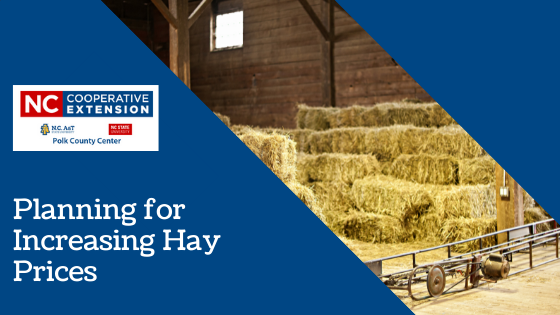Planning for Increasing Hay Prices
go.ncsu.edu/readext?834811
en Español / em Português
El inglés es el idioma de control de esta página. En la medida en que haya algún conflicto entre la traducción al inglés y la traducción, el inglés prevalece.
Al hacer clic en el enlace de traducción se activa un servicio de traducción gratuito para convertir la página al español. Al igual que con cualquier traducción por Internet, la conversión no es sensible al contexto y puede que no traduzca el texto en su significado original. NC State Extension no garantiza la exactitud del texto traducido. Por favor, tenga en cuenta que algunas aplicaciones y/o servicios pueden no funcionar como se espera cuando se traducen.
Português
Inglês é o idioma de controle desta página. Na medida que haja algum conflito entre o texto original em Inglês e a tradução, o Inglês prevalece.
Ao clicar no link de tradução, um serviço gratuito de tradução será ativado para converter a página para o Português. Como em qualquer tradução pela internet, a conversão não é sensivel ao contexto e pode não ocorrer a tradução para o significado orginal. O serviço de Extensão da Carolina do Norte (NC State Extension) não garante a exatidão do texto traduzido. Por favor, observe que algumas funções ou serviços podem não funcionar como esperado após a tradução.
English
English is the controlling language of this page. To the extent there is any conflict between the English text and the translation, English controls.
Clicking on the translation link activates a free translation service to convert the page to Spanish. As with any Internet translation, the conversion is not context-sensitive and may not translate the text to its original meaning. NC State Extension does not guarantee the accuracy of the translated text. Please note that some applications and/or services may not function as expected when translated.
Collapse ▲As with many industries this past year, agriculture and hay production have seen extreme rises in input costs and difficulty sourcing materials and labor. If you haven’t sourced all of your hay for winter yet, expect this to be reflected in hay prices and availability across the country, with continued increasing costs likely. With some fertilizer products reaching record highs, paired with increased fuel costs, many may seek more local options for hay sources this year. When asked about selecting the best hay, often my advice is the best hay is the one that meets your animal’s nutrient requirements at the most economical price.
Hay quality can be a little ambiguous amongst consumers and producers, as it can refer to animal performance, nutritional components, or its physical attributes. We begin to assess quality by using our senses when we check for the presence of weeds, mold, and color. In fact, your eyes can help evaluate the most critical factor affecting forage quality–maturity–by looking for seed heads, stems, and leaves. Often, we find that a mid-mature to mature cool-season hay (tall fescue, orchardgrass, and timothy) or mid-mature warm-season species (bermudagrass or crabgrass) will meet the needs of most mature horses, dry cows, and other livestock species; however, there can be more variation within a grass species than across species. For example, there will likely be more disparity in quality comparing early-cut orchardgrass to late-cut orchardgrass than when comparing mid-mature fescue to mid-mature timothy. This is why a chemical analysis far more accurate and useful in determining the quality of our hay and in matching it to our animals’ energy needs and nutrient requirements.
Ideally, a forage analysis should represent hay from the same field with similar cutting dates and conditions. While good hay producers do their best to manage for consistency, ask about available forage analyses for different lots of hay, which can differ in quality. Talk with your supplier about splitting the sampling cost if they don’t offer a sample analysis. Your Extension agent is a good source for collecting samples, selecting the appropriate tests, and interpretation. Once you receive your results, some of the main things to focus on when you see the analysis reports are:
Dry Matter (DM)– This tells you how much of the sample is left after water is removed. Hay will generally be about 89 percent dry matter or greater.
Digestible energy (DE) – Calorie content of the hay most often used in balancing equine rations. For a light-working horse, DE should be 20.5 Mcal/day. Hay can range from .76 to .94 Mcal/pounds or higher of DE. Total
Digestible Nutrients (TDN) – Another measure of energy used more often in livestock. It may range from 40 to 55 percent.
Crude Protein (CP)– This is a measure of the protein concentration of the hay and can range from 6 percent in native grass hays to about 15 percent or higher in high quality legume hays.
Neutral Detergent Fiber (NDF) – This is a measure of the plant’s cell wall content, shown as a percent. The higher this is, the less digestible the hay is and less the animal will eat.
Acid Detergent Fiber (ADF) – This is a measure of the fiber concentration of the hay, shown as a percent. As ADF increases, digestibility and nutrient availability decreases.
Non-Structural Carbohydrates (NSC) –Percent of simple sugars, starch, oligosaccharides (fructans). A potential concern for horses prone to metabolic disorders. Timothy and alfalfa hay may have a 15 percent or 20 percent NSC value, respectively. The N.C. Department of Agriculture and Consumer Services does not offer this test, although other commercially available laboratories do.
As prices continue to rise, cleaning out some extra space in the hay shed may pay for itself quickly. So make your preparations and use forage sampling as a tool to get the best hay for your horse. A hay analysis will help you to make sound nutrition and economic decisions.
View the first half an hour of Cassie’s recent seminar on “Selecting Quality Horse Hay” on our Extension Youtube Channel.





